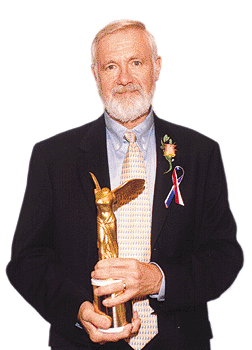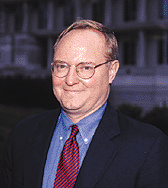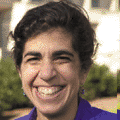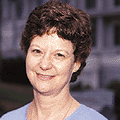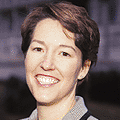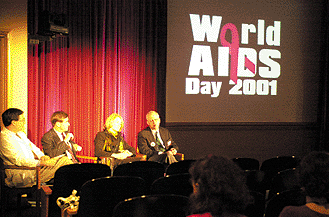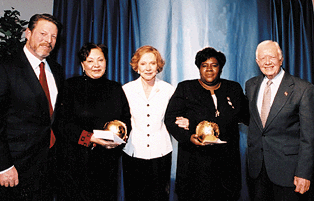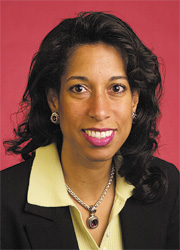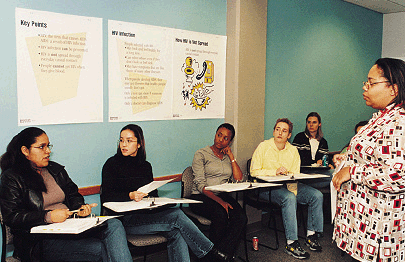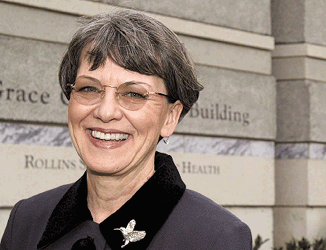In BriefOur world class hero and Lasker laureateEmory acquires Aetna outcomes powerhouse Environmental Impact (Global and Environmental Health) Remembering a continuing plague ZAPPing Asthma Startling statistics on sexual behavior An Activist Edge (RSPH - GPHA) Religious beliefs and the family way In Good Company (Eric Ottesen)
The Lasker selection committee honored Foege because his “entire career has been defined by an unwavering optimism that global diseases can be conquered; the willingness to risk professional reputation on untried, creative strategies; and the determination to do whatever was necessary, even at great personal cost, to improve the health of people.” Foege’s acceptance speech echoed a philosophy that has improved the lives of millions. “What is better than science?” he asked. “Better than science is science with heart, science with ethics, science with equity, science with justice.” He called for international cooperation to combat the public health threats of disease and starvation that kill 30,000 children under the age of 5 worldwide every day. “Not one of us can do much alone,” said Foege. “The power is in the accumulation of every last one of us, bound together in shared goals, adding our paltry daily allowance . . . the contributions of millions of people in research and academics.” After Foege’s successes in Africa, he was named head of the smallpox eradication program at the Centers for Disease Control and Prevention and later director of the entire agency. During his tenure, from 1977 to 1983, CDC researchers discovered toxic shock syndrome’s link to tampons, and Reyes syndrome’s association with aspirin use in children. Foege also established the first task force on AIDS, led by James Curran, now dean of the RSPH. In 1984, Foege formed the Task Force for Child Survival, a working group for the World Health Organization, UNICEF, the World Bank, the United Nations Development Program, and the Rockefeller Foundation. The group increased childhood vaccination rates worldwide significantly in just six years. He later became the executive director of The Carter Center, helping combat diseases from Guinea worm to river blindness. In 1999, he became senior medical adviser to the Bill and Melinda Gates Foundation, the world's largest philanthropic organization, which has given $1.9 billion so far to health-related projects around the world.
The group was established in 1992 as the Prudential Center for Health Care Research under the leadership of former CDC director Bill Roper. Jeff Koplan then led the group before he became director of CDC. The group later moved to Aetna, the largest managed care organization in the nation, as part of Aetna’s purchase of Prudential Health Care. Kenneth Thorpe, director of the new center and chair of Health Policy and Management, says this highly accomplished group looks forward to collaborating with Emory researchers on a wide variety of health services research studies. “This group has published prolifically on chronic diseases like diabetes and heart disease and cancer screening, reproductive health, health literacy, and barriers to immunization, among many other topics. “What distinguishes this particular type of research is that it aims for results.”
As a health education specialist at Grady Memorial Hospital, Kara Jacobson trained doctors to simplify communication and counsel their patients about risk factors. Jacobson, who earned an MPH from RSPH, now studies education of providers about asthma, health literacy among commercially insured diabetes patients, and electronic communication among providers.
“We’ve had students interested in environmental health issues in developing countries and international health students who realized that many of the health challenges in developing countries are environmental,” says Rheingans. Globally, population growth and increasing demand for natural resources directly and indirectly affect climate and biodiversity. They in turn affect the availability of food, clean air, and clean water, as well as disease risks. On a regional scale, patterns of urbanization, agriculture, transportation, and natural disasters affect health with their impact on food supplies, water, air, wastes, injury risks, and toxic exposures. Although environmental health challenges are more apparent in poor countries, they ultimately affect the health of the whole planet. “These are not just issues of developed countries versus underdeveloped countries,” Rheingans says. “So many of these issues, such as climate change and natural resource demand, are truly international.” Rheingans predicts an increasing demand for environmental health scientists with an international focus. “There is a lack of workers trained to deal with these challenges,” he says. “There are so many organizations and government agencies that need someone to look at the health aspects of their projects. For example, there are a lot of irrigation projects ongoing in developing countries. Someone needs to ask how these projects increase the risk of floods, how they affect local vectors for diseases, and whether they move people into environments where they have contact with disease vectors.”
Rheingans also cites a dearth of research in global environmental health. “We don’t understand the problems
occurring across the landscape well enough,” he says. “We need public health workers with an environmental
perspective to better judge the risks to global health.”
For more information, check the website:
http://www.sph.emory.edu/GLOBAL/
On November 29, three former CDC epidemiologists who were there at the beginning—including RSPH Dean James Curran—sat on stage at the Emory University Hospital auditorium. They swapped stories between clips from the movie And the Band Played On. Like much research involving AIDS, the event to commemorate World AIDS Day was an Emory-CDC collaboration. Panels from the AIDS Quilt of Remembrance hung from the walls, and every seat was filled. By the end of a program that dealt with both the scientific challenges of HIV and its human impact, hardly an eye was dry. Curran, Mary Guinan, and Harold Jaffe were members of the CDC task force that investigated the AIDS epidemic in its early years. Their stories told of an epic struggle to solve the puzzle of AIDS and make the world pay attention. “Back then, you just didn’t tell people at a party that you worked in venereal disease,” said Mary Guinan, now the state health officer for Nevada. Some of their stories were bitter, and some were simply sad. “When I recently visited an old friend from those days who is a doctor in San Francisco, he made a telling comment,” said Curran, director of the Emory Center for AIDS Research. “He said, ‘Now it’s mostly women out there marching in the parades. The men are all gone.’” The annual World AIDS Day is the result of a call by the World Summit of Ministers of Health on Programmes for AIDS Prevention in 1988 to open channels of communication, strengthen the exchange of information and experience, and forge a spirit of social tolerance. Since then, this event has been endorsed by the World Health Assembly, the United Nations, and nations around the world.
“Exposure to sexually explicit X-rated films that rarely show preventive behaviors like condom use may influence adolescents by modeling unhealthy practices,” says Wingood. She suggests that parents be educated about how viewing sexually explicit material can affect adolescents’ sexual health. Age limits required to attend, rent or purchase these films must be enforced as well. The second article also surveyed African-American female adolescents. In this study, almost 20% of teens questioned reported having been victims of dating violence. Those with a history of dating violence were less likely to use condoms, more likely to have an unfaithful partner, and more likely to fear discussing condom use or pregnancy prevention with their partner. They also reported having less control over their sexuality and were more likely to think that their friends were not supportive of using condoms. They were also more likely to test positive for STDs. “Adolescents with a history of dating violence think that having an abusive partner is the standard, and this affects their perceptions about safer sex and healthy relationships,” says Wingood. She suggests that information on teen dating violence be included within HIV, STD, and pregnancy prevention programs aimed at adolescents. Although prevention programs are most often targeted to females, their male partners must be educated as well. Both studies were funded by the Center for Mental Health Research of the National Institute of Mental Health.
“Examining a woman’s religious beliefs is a critical part of capturing a full understanding of her attitudes about an unintentional pregnancy,” says Hogue, the Jules and Deen Terry Professor of Maternal and Child Health and professor of epidemiology. “A woman may feel caught between her religious convictions and her feelings about an unhappy pregnancy.” Public health professionals often assume a woman knows about contraception if she is giving birth, she says. “That’s an erroneous assumption. Women very often either don’t have enough information about contraception, or they don’t have access to it.” Access, she says, may be limited because of finances, religious constraints, or her partner’s attitudes.
“Unintentional pregnancies can mean unhappy pregnancies,” Hogue says. “In the United States, one in
five women says she was unhappy about her most recent pregnancy. Unhappy pregnancies may open the
door to future public health issues, like abortion, divorce, and reduced parenting resources for
other children. This is primarily a problem for adult women, not teenagers. We need to do the
basic, epidemiologic research to find out how to help women and their partners achieve happy
parenting.”
Spring
2002 Issue |
Dean's Message | In
Brief | Innocence Lost | Copyright © Emory University, 2002. All Rights Reserved. Send comments to hsnews@emory.edu. | |||||||||||||||||||||||||||||||||
